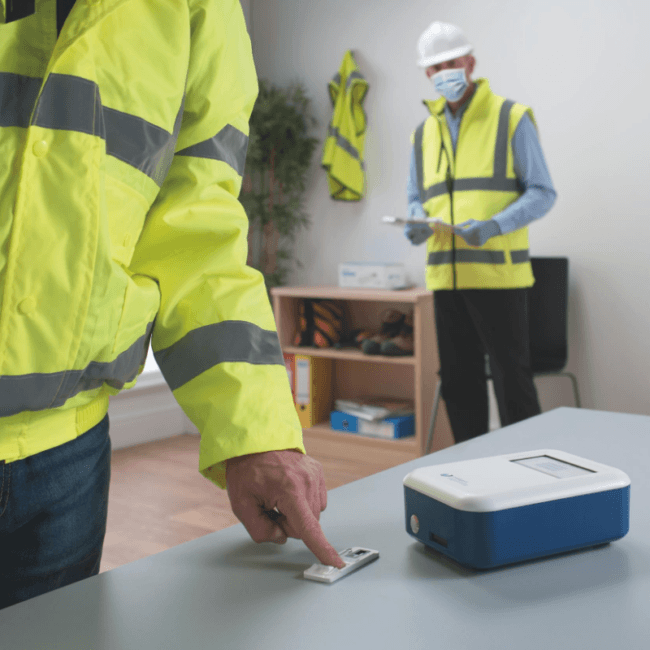No products in the cart.
Free Demo
Book A No-Obligation Demo
02.16.2022

We recently conducted a LinkedIn poll asking just this question. The top answer was: ‘it’s too time-consuming (and disruptive)’.
I’ve been involved with Intelligent Fingerprinting for over ten years now. I joined right back at the product’s early R & D stage. When developing the Intelligent Fingerprinting drug test, the team was conscious of the need to ensure that the time taken for the product to deliver results had to be faster than – or at least equivalent to – traditional testing methods.
Today, the fingerprint method can deliver results in ten minutes – which compares very favourably with saliva and urine tests. However, when talking to customers, we increasingly understand that the time issue is more about the end-to-end drug testing process as a whole, not just the actual test result time.
From my conversations with customers over the last couple of months, I have some key examples that I want to share to illustrate our faster, simpler process:
Each test may deliver results in minutes, but how many forms do you have to fill out for each person tested? Is it a combined form for both the initial screening test and, if needed, a confirmation test? Or do you have to fill everything out twice?
Intelligent Fingerprinting: Customers often report that paperwork for traditional saliva tests is cumbersome, with too many tick boxes needed to ensure adherence to the testing process. In contrast, with the fingerprint test, there is just one A4 form per sample donor to complete for both the initial screening test and, if ever required, the confirmation test. This makes the whole testing process easier and simpler to administer.
Does the test system support you by printing results / chain of custody labels for you? Or are you using your handwriting skills to manually record the results for each test? Are you having to grapple with tricky labels on tubes to record the donor’s information?
Even if it is just a 10% random workforce test that you’re doing, the cumbersome handwritten paperwork quickly becomes a pain… no matter how fast the actual test delivers its results. Also, the more details we have to write down, the more likely we’re going to make mistakes – especially if we’re having to write results on content-heavy, duplicate forms across multiple copies…. If you are testing at quantity – say 50 a day – that’s a lot of duplicate forms you are having to accurately write out with information that could influence a person’s job!
Intelligent Fingerprinting: The drug testing system should make the process as easy as possible for you. Intelligent Fingerprinting has just a single A4 form that caters for both the initial screening and, if needed, the confirmation test. We offer a printer to enable multiple label print-outs of test results for you to easily affix to each layer of the Consent Form and also share with the person being tested. And our sample cartridges are flat, so when you do have to handwrite the donor’s information on the back, you have a nice smooth surface on which to do this quickly and easily.
Testers using saliva-based tests know all about Dry Mouth Syndrome – when the sample donor doesn’t have enough saliva to make the saliva drug test work properly. Or they may have just enough saliva for one test, but not enough to provide a second sample if it’s needed for laboratory confirmation purposes following a positive screening result. This can make testing a waiting game, and an unreliable one if an inadequate sample is sent off to a laboratory for confirmation testing. Similarly, testers who use urine-based products will be familiar with the ongoing challenge of employees struggling to provide a urine sample. Let’s face it, we can’t all go to the toilet on demand and some people might try to delay providing a sample for other reasons!
The time wasted waiting to collect samples soon adds up. I’ve also talked with many customers who are increasingly frustrated by saliva tests that end up being wasted because of the inconclusive results they get when too little saliva is collected for the test to work properly. Then it’s not just the time that’s wasted – the cost of inconclusive drug tests soon mounts too.
Intelligent Fingerprinting: Fingerprint sweat is almost always present. Even if hands have been washed thoroughly, it only takes around 30 minutes until enough sweat becomes available for testing. With the added convenience of the system’s portability and ease-of-use in almost any setting, samples can also be collected at multiple workplace sites, significantly reducing the time employees must take out of their workday for testing.
Do these practical frustrations reflect your feelings about traditional drug testing? If so, contact us to book a no-obligation demo where we can show you just how easy the fingerprint-based drug testing process can be. We can also share examples of how other organisations in your sector are putting the Intelligent Fingerprinting system to work.
My next article will look in more detail at the cost savings that can be realised through these process efficiencies. In the meantime, should you have any questions about fingerprint-based drug testing, please don’t hesitate to get in touch.